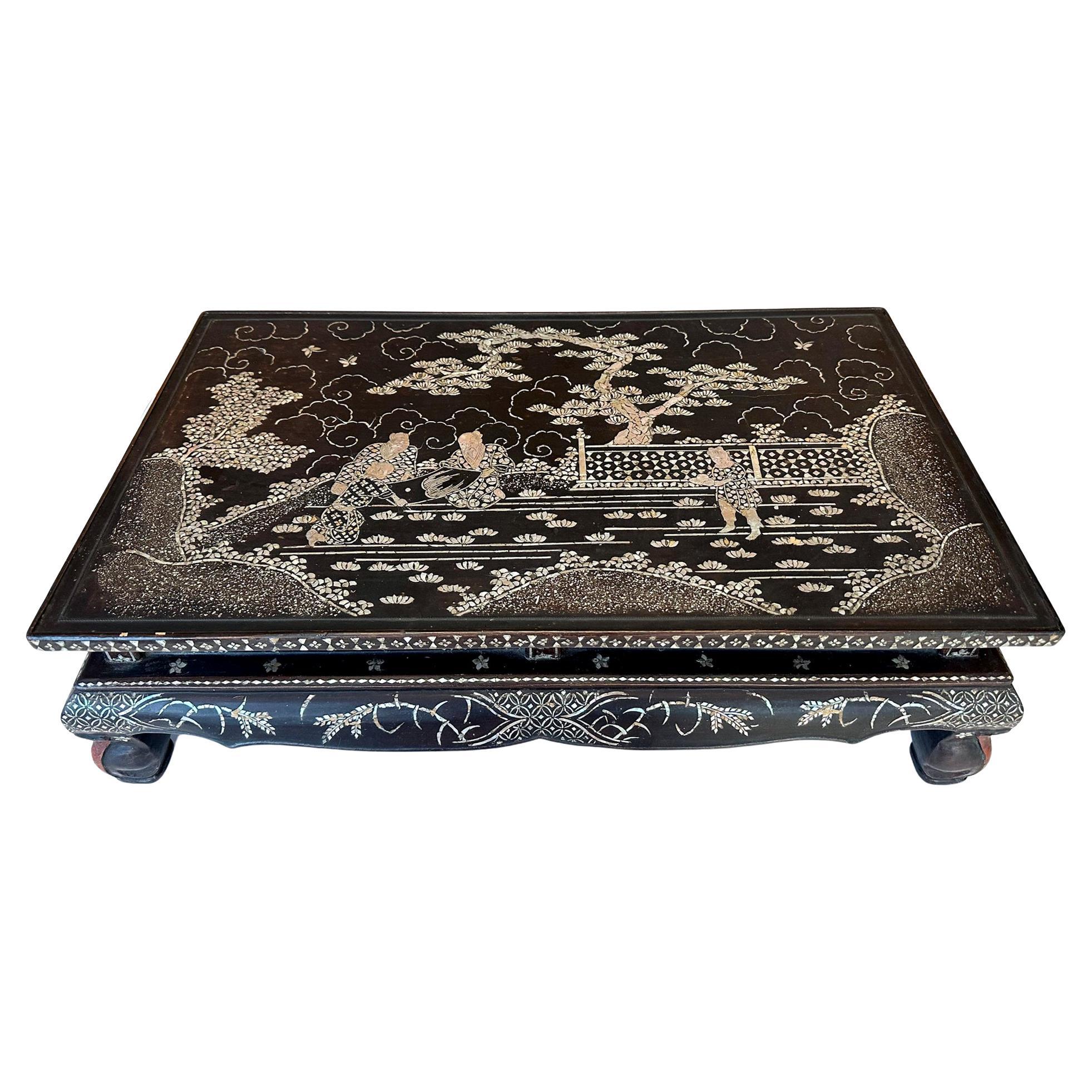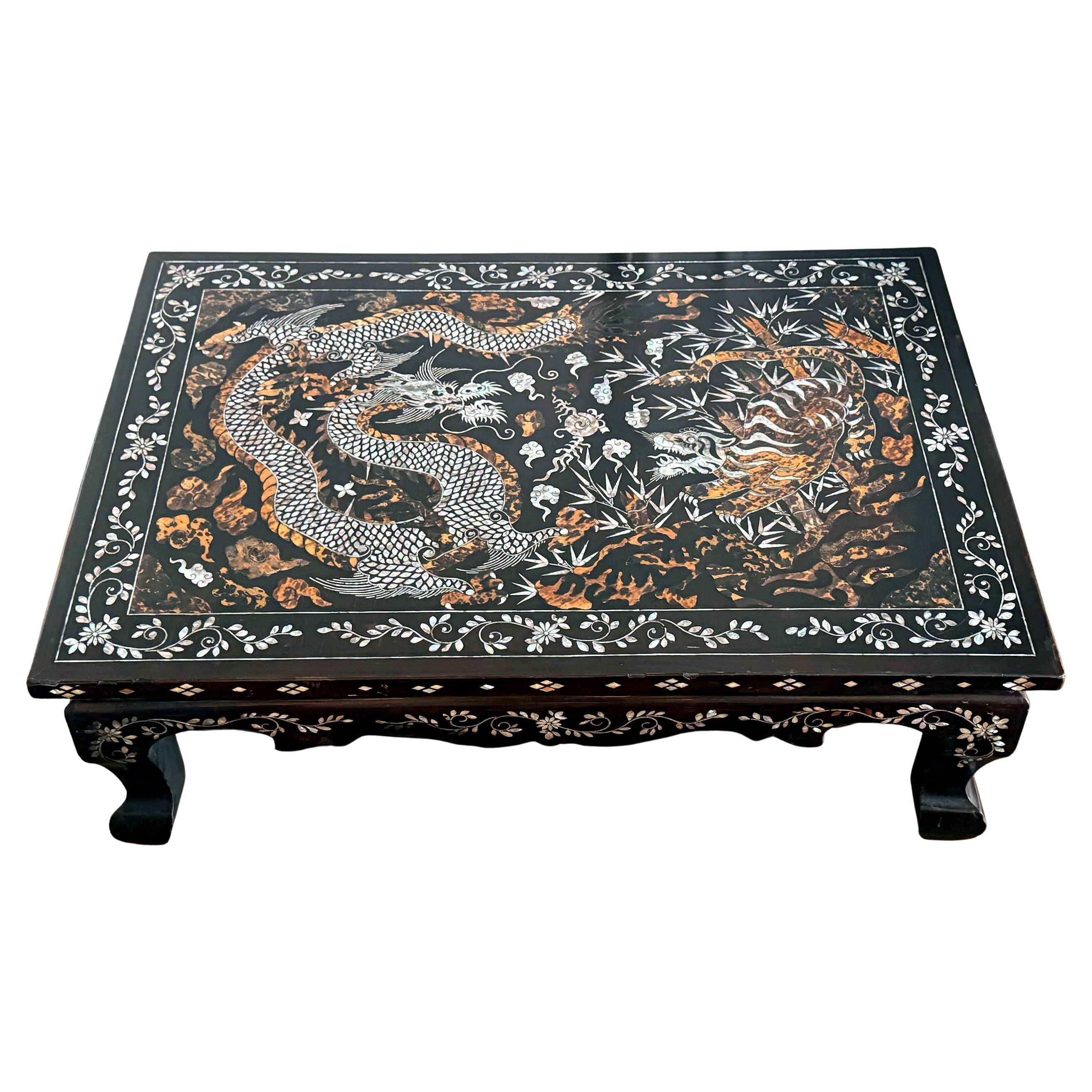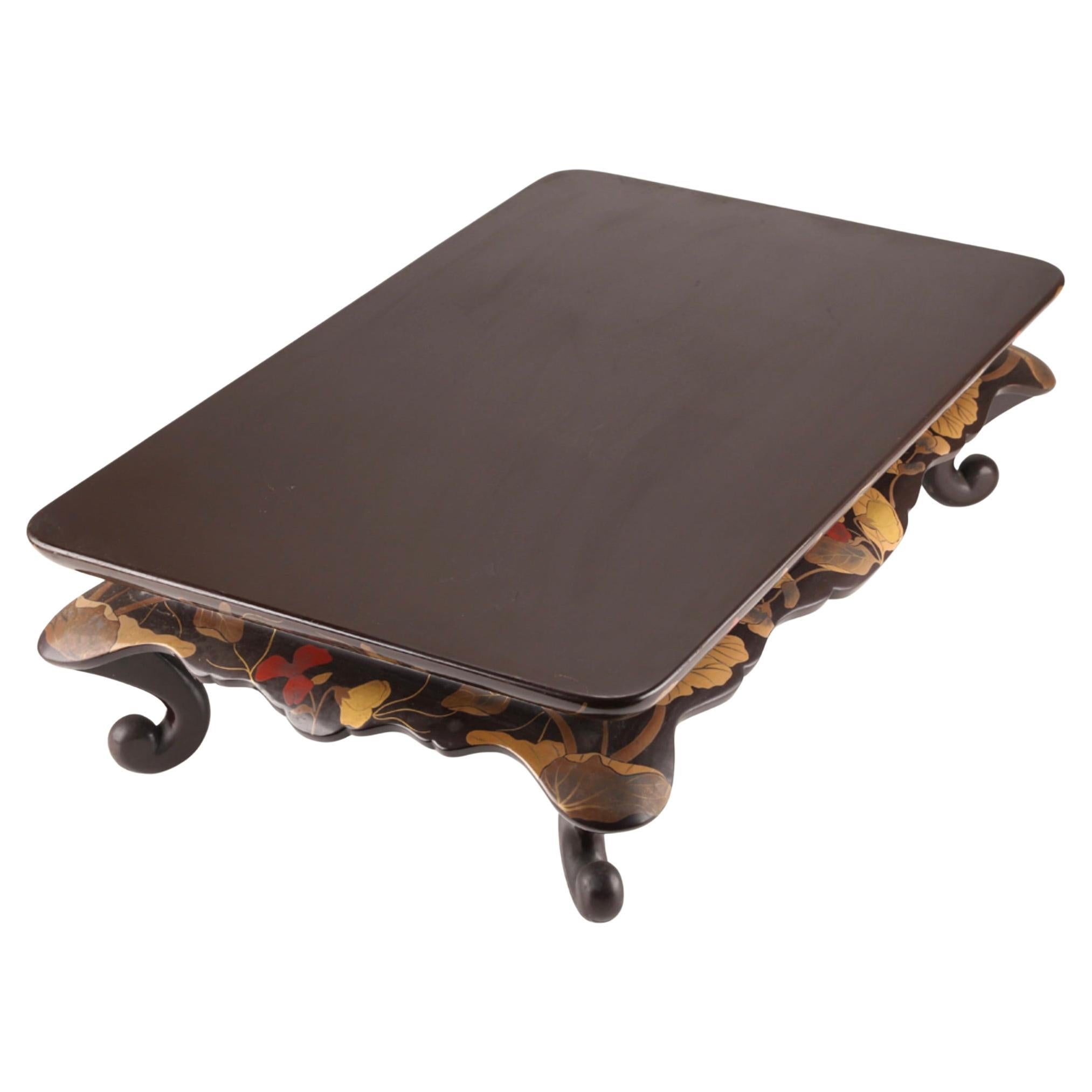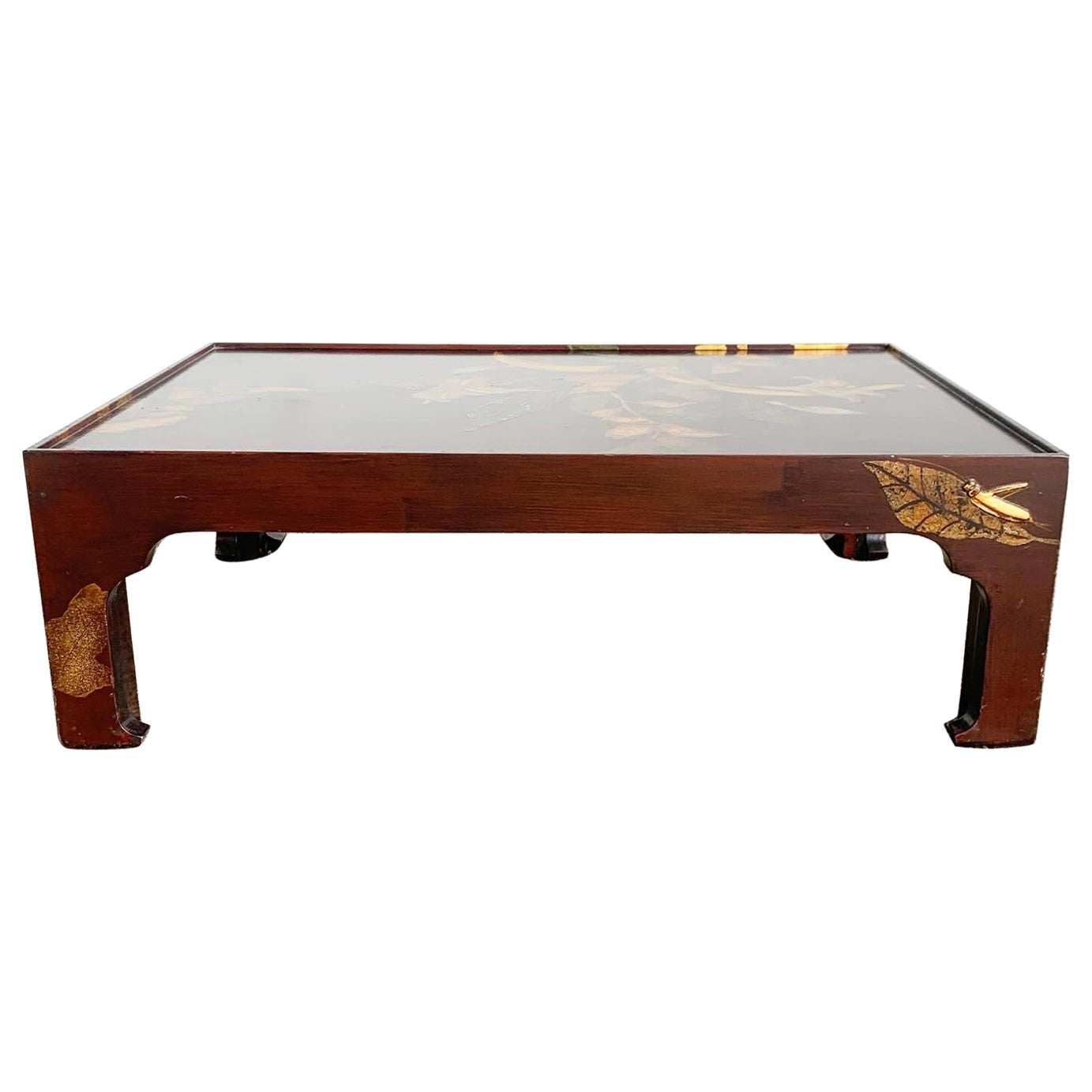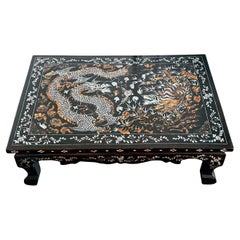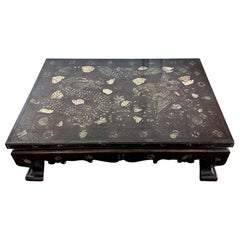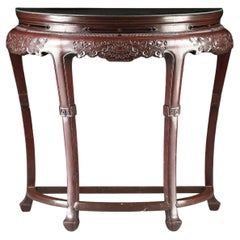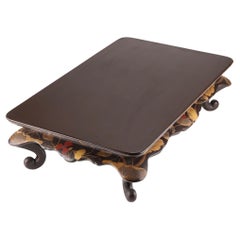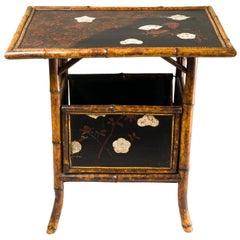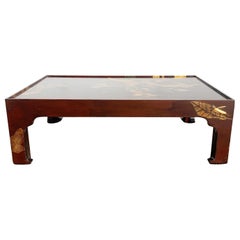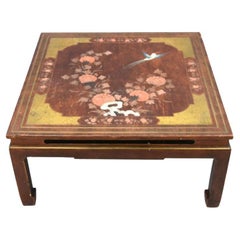Items Similar to Antique Japanese Lacquer and Inlay Table from Ryukyu Islands
Want more images or videos?
Request additional images or videos from the seller
1 of 19
Antique Japanese Lacquer and Inlay Table from Ryukyu Islands
$5,000
£3,788.45
€4,346.94
CA$7,035.81
A$7,734.29
CHF 4,064.79
MX$93,922.42
NOK 50,707.19
SEK 48,041.50
DKK 32,442.34
About the Item
A small square-form table with lacquer and intricate mother-of-pearl inlay design from Ryukyu Islands kingdom circa 17-18th century. Ryukyuan kingdom was used to be an independent island country until it was officially annexed by Japan in 1879 during Meiji period and ultimately became Okinawa Prefecture. Its traditional lacquerware production and design was influenced by many surrounding cultures such as Chinese, Japanese, Korean and Southeast Asian and emerged as a distinct and style of its own. Gold paint on red lacquer background and extensive and fine workmanship of Raden shell inlays are two easily recognizable and iconic features of the Ryukyuan lacquerware.
The table, with its slightly raised edges on top, supporting apron, curvy cabrioles legs with red fins and connecting stretchers on the base, is a classic design often found on Ryukyu Islands. Its origin was likely from the Chinese prototype of "Incense Burner Table". The extensive inlay work on the top surface depicts a classic literary scene where two scholars greeting each other in the front yard of a dwelling. The setting is bucolic with pines and flowering trees on the background and the rustic gate, fences and abode suggest humbleness and hermitage. This type of imagery became popular in China since Ming Dynasty. The apron, legs and stretcher bars were all decorated with various inlay designs such as floral and turtleback patterns, weeping willow branches, scrolling vines and grasses.
For reference on a similar table, see figure 130 in the Japanese version book "The Art of Ryukyuan Lacquerware" as shown in the last photo.
- Dimensions:Height: 15.5 in (39.37 cm)Width: 15.5 in (39.37 cm)Depth: 13 in (33.02 cm)
- Style:Edo (Of the Period)
- Materials and Techniques:
- Place of Origin:
- Period:
- Date of Manufacture:17-18th Century
- Condition:Wear consistent with age and use. Fine antique condition with patina such as small surface mark and some accumulation especially toward the corners. Minimal loss of inlays. Presents nicely.
- Seller Location:Atlanta, GA
- Reference Number:1stDibs: LU945038412512
About the Seller
4.9
Platinum Seller
Premium sellers with a 4.7+ rating and 24-hour response times
Established in 2006
1stDibs seller since 2010
570 sales on 1stDibs
Typical response time: <1 hour
- ShippingRetrieving quote...Shipping from: Atlanta, GA
- Return Policy
Authenticity Guarantee
In the unlikely event there’s an issue with an item’s authenticity, contact us within 1 year for a full refund. DetailsMoney-Back Guarantee
If your item is not as described, is damaged in transit, or does not arrive, contact us within 7 days for a full refund. Details24-Hour Cancellation
You have a 24-hour grace period in which to reconsider your purchase, with no questions asked.Vetted Professional Sellers
Our world-class sellers must adhere to strict standards for service and quality, maintaining the integrity of our listings.Price-Match Guarantee
If you find that a seller listed the same item for a lower price elsewhere, we’ll match it.Trusted Global Delivery
Our best-in-class carrier network provides specialized shipping options worldwide, including custom delivery.More From This Seller
View AllAntique Japanese Lacquer and Inlay Kang Table from Ryukyu Island
Located in Atlanta, GA
A small low table with lacquer and intricate mother-of-pearl inlay design from Ryukyu Islands kingdom circa 17-18th century. Ryukyuan kingdom was used to be an independent island cou...
Category
Antique 18th Century Japanese Edo Lacquer
Materials
Mother-of-Pearl, Lacquer
Musuem Quality Antique Korean Table with superb Inlay Joseon Dynasty
Located in Atlanta, GA
A Korean black lacquered wood low table with fine inlay works circa Joseon dynasty (19th century), Musuem quality. The low table was traditionally placed on the floor or bed and mean...
Category
Antique 19th Century Korean Other Furniture
Materials
Tortoise Shell, Mother-of-Pearl, Wood, Lacquer
Antique Korean Lacquer Coffee Table with Elaborate Inlays
Located in Atlanta, GA
A Korean lacquered wood low table with exotic elaborate inlay work circa 19th century (Joseon Dynasty). The low table, supported by slightly curved legs, was traditionally placed on the floor or bed in as a luxury item in a noble wealthy household. Like Soban, the low profile was meant to be used sitting down on the floor or matt. It is suitable to be used as a coffee table for modern time. With its rectangular form, the prototype was likely from Chinese Kang table. Lacquered in black (with time the color always turned slightly brownish due to oxidation caused by light), the table showcases elaborate inlay work with exotic materials including crushed Mother-of-Pearl, golden tortoise shell, stingray Shagreen and twisted brass wires. The iconic motif in the center is "Dragon and Phoenix Chasing Fire Pearl", an auspicious symbol often used in wedding ceremony. The eyes of the dragon and phoenix were heighted with MOP shells. The horns and beards of the dragon were made of tortoise shell. The textured scale and feature were depicted with Shagreen. The mythological animals are surrounded with clouds formed by inlayed brass wire and islands of crushed MOP. On four corners anchored a square motif each with symbol of Bagua with four trigrams. Impressively, the fine inlay work continued onto the outer border. Buddhism symbols such as fans, pair of chimes, conch, and ribbons were depicted in great details. The aprons are also decorated with brass wire scrolls and various floral motifs in shagreen.
The design on this table is of classic motif found in Korea lacquer table...
Category
Antique 19th Century Korean Other Furniture
Materials
Wood, Lacquer
Antique Chinese Demilune Lacquered Table Late Qing Dynasty
Located in Atlanta, GA
A Chinese demilune console table circa second half of 19th century (the late Qing dynasty; 1644-1912). Made in pair always, the D shaped table was so named because it resembles half-...
Category
Antique 19th Century Chinese Qing Furniture
Materials
Wood
Lacquered Korean Low Coffee Table with Elaborate Inlays
Located in Atlanta, GA
A Korean black lacquered wood low table with elaborate inlay works circa late Joseon dynasty (late 19th century to turn of 20th century). The low table, supported by slightly curved ...
Category
Antique Late 19th Century Korean Other Furniture
Materials
Brass
Antique Korean Sutra Desk Lacquer with Mother of Pearl Inlays Joseon Dynasty
Located in Atlanta, GA
An antique lacquered wood desk (Gyeongsang) with mother of pearl inlays from Korea circa mid-19th century. The form of this small table is typical of a sutra reading desk with the en...
Category
Antique Mid-19th Century Korean Other Furniture
Materials
Mother-of-Pearl, Wood, Lacquer
You May Also Like
Exceptional 19th Century Wajima Lacquer Low Table with Gold Makie Decoration
Located in Fukuoka, JP
An exquisite antique Japanese low table (hiradaku) from the 19th century, crafted in the renowned Wajima lacquer tradition of the Noto Peninsula. The table features a deep, lustrous ...
Category
Antique 19th Century Japanese Meiji Furniture
Materials
Wood, Lacquer
English Table with Lacquer Japanning, Eggshell Design and Bamboo
Located in Hudson, NY
English table with lacquer japanning, eggshell design and bamboo, Japanning is a term used for when Europeans mimic Japanese lacquer by applying a hard, black surface to an item. Thi...
Category
Antique Early 1900s British Side Tables
Materials
Eggshell, Bamboo
Vintage Asian Wooden Inlaid Asian Prayer Table
Located in Delray Beach, FL
The Vintage Asian Wooden Inlaid Prayer Table is a stunning display of traditional Asian craftsmanship. Featuring intricate wooden inlays with delicate foliage designs, it reflects th...
Category
20th Century Chinoiserie Side Tables
Materials
Wood
$556 Sale Price
20% Off
Late 19th Century Painted Lacquered Asian Tea Table
Located in Marseille, FR
Asian lacquered tea table painted late 19th century, height 39 cm for a size of 80 cm by 80 cm.
Additional information:
Style: Asian
Material: L...
Category
Antique 19th Century Card Tables and Tea Tables
Materials
Lacquer
Vintage Chinese Oriental Black Lacquer Hand Painted Low Asian Side Table
Located in Philadelphia, PA
Vintage Chinese Oriental Black Lacquer Hand Painted Low Asian Side Table. Item features nice low form, carved and hand painted scenes with women, ...
Category
Mid-20th Century Chinese Export Side Tables
Materials
Wood
Japanese Lacquered Box / Altar Table, Mid-20th Century
Located in New York, NY
A Japanese lacquered altar table / box, Showa period, 1937.
Teak and Cedar, lacquered in read and black on the outside. Exquisitely carved dragon design in the front and back. The...
Category
Vintage 1930s Japanese Meiji Tray Tables
Materials
Wood
More Ways To Browse
Shell Inlay
Chinese Black And Gold Lacquered
Black Lacquer Mother Of Pearl
18th Century Japanese Art
Square Lacquer Table
Antique Shell Inlay
Japanese Black Tables
Japan Lacquer Table
Japanese Lacquered Table
Japanese Inlay
Black Lacquer Mother Of Pearl Inlay Furniture
Chinese Furniture With Mother Of Pearl Inlay
Black Lacquer Inlay
Chinese Incense
Chinese Lacquer Mother Of Pearl
Chinese Lacquer And Mother Of Pearl
Antique Japanese Lacquer Tables
Willow Pattern
